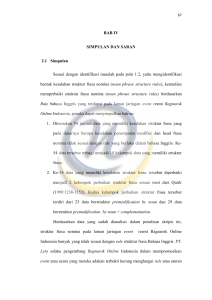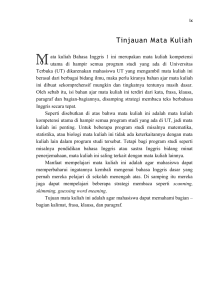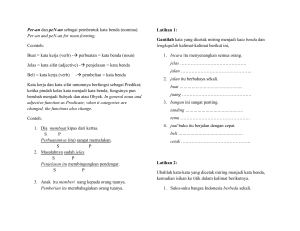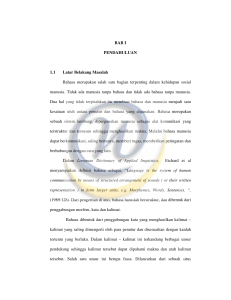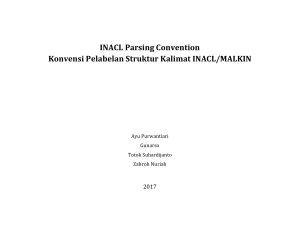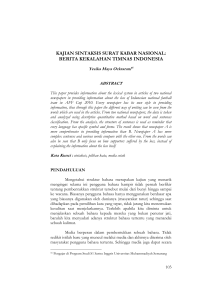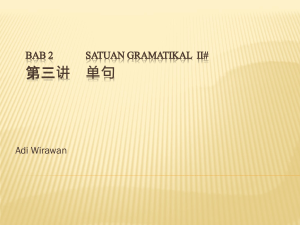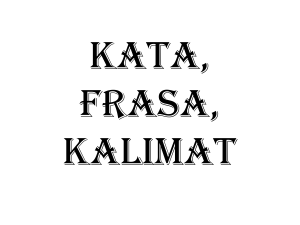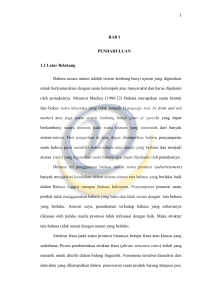BAB II KAJIAN PUSTAKA Seperti yang disebutkan sebelumnya
advertisement
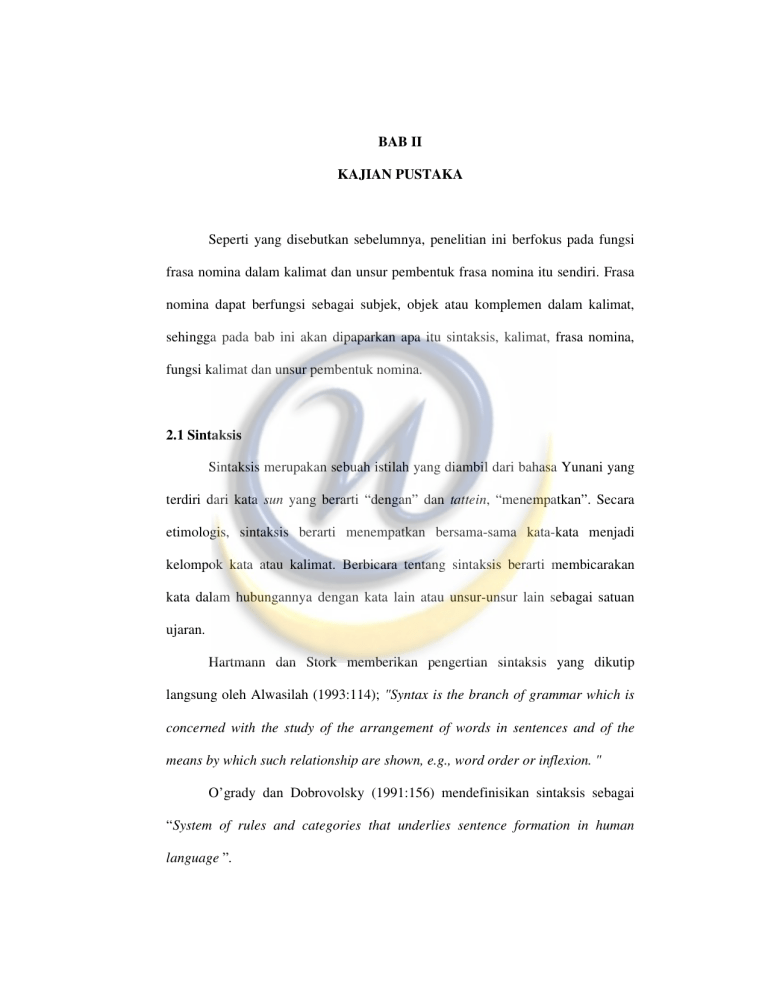
BAB II KAJIAN PUSTAKA Seperti yang disebutkan sebelumnya, penelitian ini berfokus pada fungsi frasa nomina dalam kalimat dan unsur pembentuk frasa nomina itu sendiri. Frasa nomina dapat berfungsi sebagai subjek, objek atau komplemen dalam kalimat, sehingga pada bab ini akan dipaparkan apa itu sintaksis, kalimat, frasa nomina, fungsi kalimat dan unsur pembentuk nomina. 2.1 Sintaksis Sintaksis merupakan sebuah istilah yang diambil dari bahasa Yunani yang terdiri dari kata sun yang berarti “dengan” dan tattein, “menempatkan”. Secara etimologis, sintaksis berarti menempatkan bersama-sama kata-kata menjadi kelompok kata atau kalimat. Berbicara tentang sintaksis berarti membicarakan kata dalam hubungannya dengan kata lain atau unsur-unsur lain sebagai satuan ujaran. Hartmann dan Stork memberikan pengertian sintaksis yang dikutip langsung oleh Alwasilah (1993:114); "Syntax is the branch of grammar which is concerned with the study of the arrangement of words in sentences and of the means by which such relationship are shown, e.g., word order or inflexion. " O’grady dan Dobrovolsky (1991:156) mendefinisikan sintaksis sebagai “System of rules and categories that underlies sentence formation in human language ”. Richards, et al (1985: 285) menyebutkan definisi sintaksis sebagai berikut: "Syntax is the study of how words combine to form sentences and the rules which govern the formation of sentences." Dari beberapa definisi di atas dapat kita simpulkan bahwa sintaksis merupakan sebuah cabang ilmu linguistik yang mempelajari hal yang berhubungan dengan proses pembentukan kalimat. 2.2 Kalimat Nida dan Taber (1968:208) berpendapat bahwa sebuah kalimat adalah “… a grammatical construction composed of one or more clauses arranged according to prescribed patterns, and capable of standing by itself as a complete unit”. Mereka mendefinisikan kalimat sebagai konstruksi gramatikal yang terdiri atas beberapa klausa dan tersusun atas pola yang telah ditentukan dan dapat berdiri sendiri. Berdasarkan tata bahasa tradisional bahasa Inggris, definisi kalimat dapat dibagi berdasarkan makna dan fungsinya, Frank (1972:220). Berdasarkan makna, "a sentence is a complete thought", sedangkan berdasarkan fungsi, "a sentence is a fall predication containing a subject plus a predicate with a finite verb. Dari pendapat-pendapat tersebut, dapat kita simpulkan bahwa kalimat merupakan gabungan beberapa kata yang mempunyai makna tertentu yang ditandai dengan huruf kapital di permulaan kalimat dan diakhiri dengan tanda baca tertentu. 2.3 Unsur – unsur dalam kalimat Ada beberapa unsur yang membentuk sebuah kalimat dalam bahasa Inggris. Unsur-unsur ini disusun sesuai dengan fungsinya dalam kalimat. Unsurunsur kalimat pada urutannya terbagi atas: Subject, Verb, Object, Complement dan Adverb. 2.3.1 Subjek (Subject) The subject of the sentence has a close general relation to 'what is being discussed', the 'theme' of the sentence, with the normal implication that something new (the predicate) is being said about a 'subject' that has already been introduced in earlier sentence. (Quirk & Greenbaum, 1973: 11). Subjek sebuah kalimat merupakan sesuatu yang dibicarakan yang berada di awal kalimat. Subjek dapat berupa kata atau kelompok kata dan memiliki kelas kata sebagai nomina atau kata benda. Untuk menentukan subjek dari sebuah kalimat dapat menggunakan kata tanya who/ siapa atau what/ apa. Contoh 1 The driver had the standard New York cabdriver look. (GH, 1991:125) Contoh 2 Samantha was angelic on the flight. (GH, 1991:123) Pada contoh 1, subjek pada kalimat tersebut adalah the driver yang merupakan kelompok kata terdiri dari artikel the dan nomina driver. The driver merupakan sesuatu yang dibicarakan dalam kalimat. Pada contoh 2, subjek pada kalimat tersebut adalah Samantha yang berkelas kata nomina. 2.3.2 Verba (Verb) Richards, et al (1985: 305) memberikan definisi verba sebagai berikut, A verb is a word which, a) occurs as part of the predicate of a sentence, b) carries markers of grammatical categories such as tense, aspect, person, number, and mood, and c) refers to an action or state. Verba adalah kata yang merupakan bagian dari predikat dalam sebuah kalimat, membawa penanda kategori gramatikal kala, aspek, persona, modus dan mengacu pada tindakan atau keadaan. Sementara itu Frank (1972; 48) mengatakan "Predicating verb is the chief word in the predicate that says something about the subject." Verba predikatif adalah kata utama yang menerangkan sesuatu tentang subjek. Verba dapat berbentuk be atau auxilary. Verba kalimat dapat pula berbentuk kata atau frasa. (Quirk & Greenbaum, 1973:17) Contoh : He left the room as I rolled into my pillow. (GH, 1991:116) Verba dalam kalimat majemuk yang dihubungkan dengan konjungsi as tersebut adalah left yang menerangkan sesuatu tentang subjek yaitu He yang berbentuk kata ganti atau pronoun. Rolled juga merupakan verba yang menerangkan sesuatu tentang subjek anak kalimat tersebut yaitu I berbentuk kata ganti atau pronoun. 2.3.3 Objek (Object) Richards, et al (1985 : 198) mengemukakan definisinya mengenai objek sehagai berikut: "Object is the noun, noun phrase or clause or pronoun in sentences with transitive verbs, which is traditionally described as being affected by the action of the verb. The object of a verb can be affected by the verb either directly or indirectly”. Pendapat tersebut menyatakan bahwa objek adalah nomina, frasa nomina atau klausa atau kata ganti dalam kalimat dengan verba transitif yang secara tradisional dipengaruhi oleh verba. Dilancarkan dari halaman http://www.learnenglish.de/grammar/sentencetext.htm#Object, The object is the person or thing affected by the action described in the verb (02 Jan 08, 20:28 wib). Objek adalah orang atau benda yang dipengaruhi oleh tindakan yang dijelaskan dalam kata kerja atau verba. 2.3.4 Pelengkap (Complement) Richard, et. Al, berpendapat bahwa, Complement is part of the sentence which follows the verb which thus completes the sentence (1985:52). Komplemen adalah bagian dari kalimat yang mendahului kata kerja dengan demikian melengkapi kalimat. A complement is the part of the sentence that gives you more information about the subject (a subject complement) or the object (an object complement) of the sentence (http://www.learnenglish.de/grammar). Komplemen adalah bagian dari kalimat yang memberikan keterangan lebih pada subjek (subjek komplemen) atau objek (objek komplemen) dari kalimat. 2.4 Frasa Bloomfield (1933:42) menyatakan yang dimaksud dengan frasa adalah “…a free form which consists entirely of two or more lesser free forms…” atau suatu konstruksi yang dapat dibentuk oleh dua kata atau lebih tetapi yang tidak mempunyai ciri konstruksi sebuah klausa dan sering pula ia mengisi slot atau gatra dalam tingkat klausa. Sebuah frase sekurang-kurangnya dua anggota pembentuknya. Anggota pembentuk ialah bagian sebuah frase yang terdekat atau langsung membentuk frase itu. Pengertian lain dari frasa yang dikemukakan oleh Richards, et al. (1985:39) adalah sebagai berikut: "a phrase is a group of two or more words which can be used as a grammatical unit within a sentence." Thatcher (1971:625) dalam The New Webster Encyclopedia Dictionary of the English Language, memberikan pengertian frasa sebagai, Two or more words forming a complete expression by themselves or being a portion of a sentence. Dari beberapa pendapat tersebut, dapat kita simpulkan bahwa frasa merupakan kumpulan kata atau lebih dari penggabungan beberapa kelas kata yang membentuk makna. Frasa setidaknya terdiri dari dua kata atau lebih yang memiliki makna tertentu. 2.5 Nomina Dalam Oxford Advanced learner’s dictionary, Hornby (2000:791) mengatakan bahwa “Noun is used to name or identify any class of things, people, place, ideas or one of these”. Frank (1976:6) menyebutkan bahwa “The noun is one of the most important part of speech, its arrangement with the verbs which helps to form the sentence core, which is essential to every complete sentence. In addition, it may function as the chief or “Head “ words in many structure of modification “. Dapat disimpulkan bahwa nomina merupakan kata yang digunakan untuk mengidentifikasi atau menamakan semua hal yang dibendakan semisal nama orang, tempat, benda atau gagasan. Nomina dapat berfungsi sebagai subjek atau objek, sebagaimana pendapat, Cowie ad. (1989:843), “Noun is a word which can be the subject or object of a verb or the object of preposition” Nomina merupakan kelas kata yang biasanya dapat berfungsi sebagai objek atau subjek dari klausa kelas kata ini sering berpaduan dengan benda atau hal lain yang dibendakan. 2.5.1 Frasa Nomina Bila kita lihat dari struktur internal, Frasa nomina adalah kumpulan kata bermakna yang hulunya merupakan nomina. Leech & Svartvik (1975:251) mengemukakan pendapat mereka mengenai frasa nomina bahwa, "a noun phrase is a phrase which can act as subject, object, or complement of a clause, or as prepositional complement. It is called a noun phrase because the word which is its head (i.e. main part) is typically a noun". Mengacu pada pendapat Leech dan Svartvik (1975 : 251), frasa nomina dapat berfungsi sebagai subjek, objek atau komplemen dalam klausa. Contoh: The boy unlocked a door at the end of the hall (GH: 130) Dari kalimat di atas, subjek dan objek masing – masing merupakan frasa nomina yaitu The boy dan a door. Quirk (1972:62) menyatakan bahwa Noun Phrase (NP) terdiri dari unsur pokok yang berjenis noun dan unsur lain yang menerangkan unsur pokok tersebut. Pada contoh The boy unlock a door at the end of the hall, subjek dan objek kalimat merupakan frasa nomina yang terdiri dari boy, door berkelas kata atau berjenis nomina sebagai head (unsur utama) dan the, a sebagai unsur determinator yang masing – masing berbentuk pointer serta counter and measure. Frasa nomina adalah satu kelompok kata yang bisa menggantikan nomina seperti yang dinyatakan Klamer bahwa frasa nomina “… is a noun group of words that can subtitute for a noun” (2000:155). Dia menyatakan bahwa purwarupa frasa nomina sederhana terdiri dari satu kelompok kata yang dapat menggantikan posisi nomina. 2.5.2 Unsur Pembentuk Frasa Nomina Dua unsur pembentuk dalam frasa nomina yaitu Head dan Modifier. Frasa nomina juga dapat dibentuk dengan menambahkan Determinator pada nomina tertentu. 2.5.2.1.Hulu (head) Dalam Longman Dictionary of Applied linguistics, Richard et al (1989 : 128) mengatakan bahwa, “head is the central part of phrase (other elements in the phrase are in some grammatical or semantic relationship) to the head” . Hulu (head) merupakan unsur utama pada sebuah frasa, sebagai contoh: the little girl in the red hood, kata yang bergaris bawah adalah unsur utama atau hulu (head) dari frasa the little girl dan the red hood. Quirk et al (1972 : 857, 850) dalam A Grammar of Contemporary English menjelaskan bahwa:“ Head, around which the other components cluster and which dictates cocord (for the most part) other kinds of congruence with the rest of the sentence outside the noun phrase “ . e. g The pretty girl in the corner. Dapat disimpulkan bahwa head merupakan unsur utama dalam sebuah frasa dan unsur utama dalam frasa nomina berkelas kata nomina. 2.5.2.2.Modifikator (Modifier) Kridalaksana (2001 : 139) menerangkan bahwa modifikator atau modifier adalah unsur yang membatasi, memperluas atau menyifatkan induk frasa. Close (1982 : 121 – 122) dalam Reference Grammar of Students of English menjelaskan bahwa frasa nomina yang dalam konstitusinya terdapat pola noun modifying another noun terdiri atas dua jenis, yang digunakan untuk mengetahui indikasi makna frasa nomina tersebut kedua jenis frasa nomina yang di dalamnya terdapat pola noun modifying another noun adalah: 1. Those that have, pronunciation, a nuclear stress on the first element, as in gold mine, this construction is commonly used to indicate a subclass, thus ‘ a gold mine ‘ is a subclass of ‘ mine’ and ‘ a flower ship ‘ is a subclass of ‘ ship ‘ . 2. Those: a. that have, in pronunciation, a nuclear stress on the second element, as in gold watch, i.e a watch made of gold. b. The same stress pattern as that in gold watch occurs in table drawer, a summer holiday and bed room window. Those construction indicate, that the drawer belongs to table, or that her holiday takes place in the summer. Dalam Let’s Write English ( 1980 : 107 ) Wishon & Burks berpendapat bahwa terdapat beberapa modifikator atau modifier yang dapat mengikuti nomina dalam noun phrase, mengenai modifikator yang berbentuk nomina, Wishon & Burks menyatakan sebagai berikut : “ Noun may be used to modify nouns sometimes two nouns join to form an in seperable compounds such as ice hockey, workhorse, and so on. In speech, these compounds are distinguished from seperable noun – noun combination by the occurrence of strong stress on the first noun of the compounds, instead of te second noun, which receives strong stress in the usual adjectives – noun, noun – noun combination. The usual noun - noun combination simply represent one noun modifying another. The modifying noun usually precedes the principle noun “ 2.5.2.2.1.Pre – Modifier Kies (1995:96) menjelaskan bahwa, “premodification, which comprises all the modifying or describing constituents before the head, other than the determiners” Premodifier adalah modifier yang diletakkan sebelum induk frasa (head), premodifier dapat berupa, ajektiva, nomina, partisipel (participle), kata bilangan tingkat (ordinal numeral), frasa genetif (genitive phrase), contoh: a. Those new blouses, all the red carpets (Adjective) b. Brick walls, my car wheel (noun) c. The looking crisis, broken arrow (participle) d. My first son (ordinal number) e. a boy’s toy, my daugther’s doll (genitive ) 2.5.2.2.2. Post – Modifier Kies (ibid) mengatakan bahwa, “postmodification, those which comprise all the modifying constituents placed after the head “. Postmodifier adalah modifikator yang diletakkan setelah induk frasa (head). Modifier ini dapat berupa frasa preposisi (prepositional phrase), klausa relatif (relative clause), frasa adjektif (adjective phrase), frasa infinitif (infinitive phrase), frasa nonfinitif (nonfinitive phrase) atau frasa phrase) dan komplemen (complement), contohnya : partisipel (participial a. Bee on flower (prepositional phrase) b. The gun which the suspect used to shot (relative clause) c. His decision to give up (infinitive phrase) d. Children throwing stones (nonfinitive phrase/ participial phrase) e. The nation that races are generally superior (complement) 2.5.2.3.Determinator (Determiner) Wishon & Burks (1980 : 95) menyatakan bahwa, “Determiner gives different degrees of specifity to the nouns as modify“. Selanjutnya Wishon & Burks (1980 : 96 – 97) mengklasifikasikan empat jenis determinator sesuai dengan fungsinya, yaitu : a. Determinator berbentuk counters and measures, yang digunakan dengan count nouns seperti a, an, one, two, first, second, few, a few, many (more, most), several, no, both, all, some, any, enough. b. Determinator berbentuk quantifiers yang digunakan dengan mass nouns seperti much (more, most), a lot of, little, a little, no, all, some, any, enough. c. Determinator berbentuk pointers, yang digunakan baik dengan mass nouns maupun count nouns kecuali untuk those dan these yang hanya digunakan adalah count nouns saja. Determinator berbentuk pointers ini yaitu : this, that, these, those, either, neither, the. d. Determinator berbentuk possesives digunakan baik dengan mass nouns maupun dengan count nouns, seperti my, your, her, his, our, their, its. Berdasarkan letaknya, determiner dapat diuraikan menjadi: a. Predeterminers Predeterminers adalah determiner yang mendahului determiner lain, meliputi : Determinatives : all, both, such, what, ( exclamination ) Numerical expression : double, ten times, twice, dsb. Fraction : half, one-quarter, dsb. b. Central Determiner Central determiners adalah determiner yang didahului oleh predeterminer dan diikuti oleh post determiner, meliputi: i. Article : a. Definite : the b. Indefinite : a, an ii. Prounoun : a. Demonstrative atau deitic : that, those, these, that, this b. Possessive atau personal pronouns : her, his, my, etc c. Indefinite : any, some, others, enough, much, etc d. Quantifying noun phrase : a few, a little e. Interrogative atau relative determiner : which, what. etc f. Genitive phrase : the captain’s, the biker’s, etc c. Postdeterminers Postdeterminers adalah determiner yang diletakkan setelah central determiner, meliputi : Number a. Cardinal : one, two, three, etc b. Ordinal : first, third, fourth, etc Quantifier : few, several, much, etc
